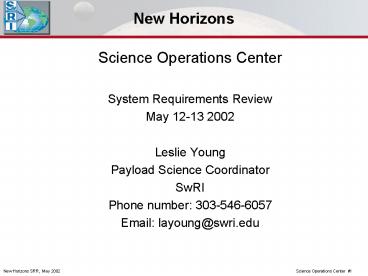Science Operations Center - PowerPoint PPT Presentation
1 / 15
Title:
Science Operations Center
Description:
Receive, archive, and analyze all instrument engineering telemetry; ... Preserve pedigree of all archived files. Avoid proprietary data formats ... – PowerPoint PPT presentation
Number of Views:38
Avg rating:3.0/5.0
Title: Science Operations Center
1
New Horizons
- Science Operations Center
- System Requirements Review
- May 12-13 2002
- Leslie Young
- Payload Science Coordinator
- SwRI
- Phone number 303-546-6057
- Email layoung_at_swri.edu
2
Science Operations Center Overview
Level 1bData
TLMData
3
Science Operations Center Top Level Requirements
- Plan and schedule all instrument activities
- Receive, archive, and analyze all instrument
engineering telemetry - Receive, archive, and reduce all instrument
science data to PDS Level 1b - Distribute science data and associated
engineering/navigation data to Ci-Is,
Participating Scientists, the EPO team, and the
PDS - Receive and archive higher level science data
products produced by the science team and - Provide facilities for partial or full Science
Team meetings as required.
4
Science Operations Center Element Locations
- Boulder TSOC (Tombaugh Science Operations
Center) Main Science Operations Center during
cruise, planning, and post-encounter - APL Secondary SOC, for use during initial
checkout, during encounters, and other critical
operations - Distributed Co-I Nodes Privileged access to SOC
data archives
5
Science Operations Center Primary functions
- Pre-flight operations
- Verify SOC operations
- Supply request files to MOC for mission
simulations - Instrument flight operations planning
- Supply request files to MOC for instrument
operations - Pipeline data processing
- Receive telemetry from MOC, produce uncalibrated
images, spectra, and timeseries - Archiving
- Source of telemetry and processed data for
Science Team, EPO, PDS
6
Science Operations Center Derived Requirements
(1 of 2)
- Communication
- Voicenet, FAX, TCP/IP between SOC, MOC, and
Science Team (including Co-I Nodes) - Videoconferencing between SOC and Co-I Nodes
- Hardware
- CPU power for data processing
- Displays for planning, data visualization
- Storage
- All New Horizons data shall be available online
for use by the Science Team - Off-site copy of all data for secure backup
purposes.
7
Science Operations Center Derived Requirements
(2 of 2)
- Software
- Maintain MOC compatibility for science planning
- Use commercial off-the-shelf (COTS) where
possible (programmatic requirement) - Distribution
- Provide telemetry and uncalibrated science data
to Science Team and EPO - Receive calibrated data and other products from
Science Team - Archiving
- Delivery of Level 1b Jupiter data to PDS by J3
months - Delivery of Level 1b Pluto-Charon data to PDS by
P4 months (Group 1) and P10 months (Group 2 and
3)
8
Science Operations Center Conceptual Design
9
Science Operations Center Verification Plan
- All requirements will be documented in the New
Horizons SOC Requirements Plan - This will include a verification matrix, with
- Verification method
- analysis
- inspection, or
- test
- Verification level
- single workstation
- internal to SOC, or
- system level
10
Science Operations Center Planned Documentation
- SOC requirements document
- Draft by PDR
- Approved before CDR
- SOC designers notebook
- Draft by PDR
- Final before CDR
- SOC users guide
- Draft during Phase C implementation
- Sections added and updated as needed.
- New Horizons Data Management Plan
- Approved by Launch 1 year
- PDS Software Interface Specification
- Approved by Launch 1 year
11
Science Operations Center Risk Identification
and Mitigation
- Primary risk
- Long-term maintainability
- Mitigation
- Obtain long-term hardware maintenance contract
- Plan migration of data storage media types
- Document pipeline processing algorithms
- Preserve pedigree of all archived files
- Avoid proprietary data formats
12
PDS Data Level Definitions 0, 0a, and 0b
- 0 The raw telemetry data as received at the
ground receiving station or ground test GSE,
organized by contacts or ground test. - 0a The telemetry data as produced by the CDH
system on the spacecraft and passed to the
telemetry subsystem. NASCOM headers and trailers
have been separated. Level 0a contains transfer
frame packets organized by contacts or ground
tests. - 0b The transfer frame packets for virtual
channels 6 and 7, plus radiometric tracking data,
all organized by contacts or ground test.
13
PDS Data Level Definitions 1, 1a, and 1b
- 1 Level 0b data that have been cleaned and
merged, time ordered, and in packet format.
Cleaned and merged means that duplicate data have
been deleted, missing packets are padded out, and
the data are organized by days. The actual format
of these data is the same as level 0b. This is
the level that should be passed to the instrument
GSE's for their processing. - 1a The level 1 data that have been separated by
instrument. - 1b The level 1a data that have been sorted by
instrument data types and instrument modes. Data
are in scientifically useful form, e.g. as images
or individual spectra. These data are still
uncalibrated.
14
PDS Data Level Definitions 2 and 3
- 2 Level 1b with calibration and corrections
applied to yield data in scientific units. - 3 Higher level data products developed for
specific scientific investigations.
15
Components of theNew Horizons Archive

